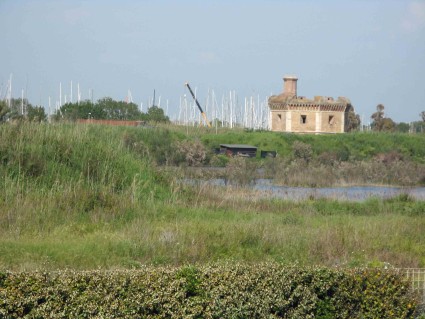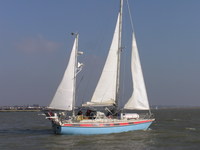
Roaring Girl
The adventures of the yacht Roaring Girl wandering the seas.
12 August 2013 | Ipswich, England
20 July 2012
20 July 2012
18 July 2012
17 July 2012
16 July 2012
10 July 2012
05 July 2012
04 July 2012
03 July 2012
03 July 2012
03 July 2012
02 July 2012 | Shanghai (high up!)
02 July 2012 | Shanghai (high up!)
02 July 2012 | Shanghai (high up!)
02 July 2012
02 July 2012 | Shanghai
01 July 2012
01 July 2012 | Moganshan Lu, Shanghai
Ostia Lido
09 May 2010

Ostia itself is a funny little town. Administratively it is part of Rome, and, with 90,000 residents, is the largest non-independent Commune in Italy. The townspeople are defiantly not Roman: if you ask a local whether they are Roman, the vehement denial will claim Ostia alone as home. In the picture are the lovely Stephan and Mauro of the chandlery in the Lido; Mauro is a great practical joker, and Stephan speaks wonderful English.
Ostia Antica, the port of ancient Rome about a mile up the Tiber, was abandoned by the fourth century AD, the river silt making it unusable, and unable to compete with larger ports up the coast. For hundreds of years not much happened around here, unless you're an Anapholes mosquito. Napoleon built the watchtower, shown in the main picture, at the first bend in the river, but that was about it.
The new Ostia was built in the late nineteenth century, largely on malarial swampland that was dug and reclaimed by fishermen brought in from Ravenna. A small part of the marshes is still left, kept as a nature reserve and home to seabirds and, we were told, otters. It's almost always deserted except for the volunteers who scythe paths through the reeds.
Ostia became an unsavoury hinterland to Rome, a place of violence and secrecy, with an appalling reputation. In the fifties, as part of the Italian film movement that worked to understand and define the post-war, Republican Italy, Ostia was a frequent film venue, used as a place to understand dislocation and distance while within easy distance of the centre of Rome. In 1975 the famous director and intellectual Pier Paolo Pasolini was murdered in the marshes, and not long afterwards, a lot of money and effort was pumped into the place.
The porto turistico is the main result of this, with space for a lot of boats, a wildly expensive boat yard, and various shops. It is a major leisure site in the town, judging by the hundreds of people who take their passegata along the front. For festivals they mount small fairs and markets, but a lot more needs to be done to make Ostia distinct from the enormous competition it faces.
You can get most of the things you need in Ostia. The unremarkable crossroads in the gallery is key for cruisers: it is home to the covered market (one of two in the town), the nearest hardware store, several big supermarkets, and a chemist. The bus to the hypermarkets at Fiumicino stops along here too.
For us, Ostia is reminiscent of the backyard to London, those parts of the Thames Gateway creating an identity that doesn't only rely on commuting to the big, congested city half an hour up the tracks. But it needs more oomph, and more inclusiveness. And most of all, it seems, it needs ways to deliver well-paid work to residents so that the local economy really benefits.
Ostia Antica, the port of ancient Rome about a mile up the Tiber, was abandoned by the fourth century AD, the river silt making it unusable, and unable to compete with larger ports up the coast. For hundreds of years not much happened around here, unless you're an Anapholes mosquito. Napoleon built the watchtower, shown in the main picture, at the first bend in the river, but that was about it.
The new Ostia was built in the late nineteenth century, largely on malarial swampland that was dug and reclaimed by fishermen brought in from Ravenna. A small part of the marshes is still left, kept as a nature reserve and home to seabirds and, we were told, otters. It's almost always deserted except for the volunteers who scythe paths through the reeds.
Ostia became an unsavoury hinterland to Rome, a place of violence and secrecy, with an appalling reputation. In the fifties, as part of the Italian film movement that worked to understand and define the post-war, Republican Italy, Ostia was a frequent film venue, used as a place to understand dislocation and distance while within easy distance of the centre of Rome. In 1975 the famous director and intellectual Pier Paolo Pasolini was murdered in the marshes, and not long afterwards, a lot of money and effort was pumped into the place.
The porto turistico is the main result of this, with space for a lot of boats, a wildly expensive boat yard, and various shops. It is a major leisure site in the town, judging by the hundreds of people who take their passegata along the front. For festivals they mount small fairs and markets, but a lot more needs to be done to make Ostia distinct from the enormous competition it faces.
You can get most of the things you need in Ostia. The unremarkable crossroads in the gallery is key for cruisers: it is home to the covered market (one of two in the town), the nearest hardware store, several big supermarkets, and a chemist. The bus to the hypermarkets at Fiumicino stops along here too.
For us, Ostia is reminiscent of the backyard to London, those parts of the Thames Gateway creating an identity that doesn't only rely on commuting to the big, congested city half an hour up the tracks. But it needs more oomph, and more inclusiveness. And most of all, it seems, it needs ways to deliver well-paid work to residents so that the local economy really benefits.
Comments
| Vessel Name: | Roaring Girl |
| Vessel Make/Model: | Maxi 120 |
| Hailing Port: | Ipswich |
| Crew: | Pip Harris and Sarah Tanburn |
| About: | Captain Sarah and Chief Engineer/Mate Pip moved on board in 2003 and finally made the break in 2006. Roaring Girl, launched in 1977, has already been round the world once, and has a lot more seamiles than the two of us put together. |
| Extra: | These pages aim to bring you our adventures as they happen, as well as Roaring Girl's sailing prowess. And to show off Pip's silverwork as well. |
Gallery not available
Who we are

Who: Pip Harris and Sarah Tanburn
Port: Ipswich

